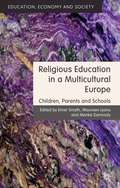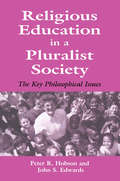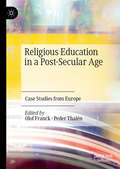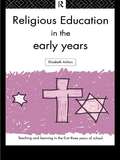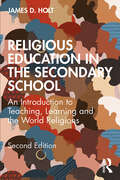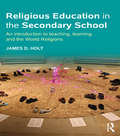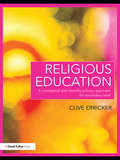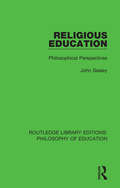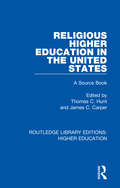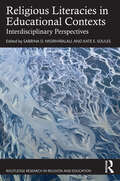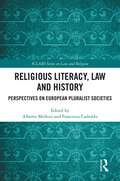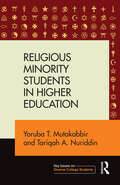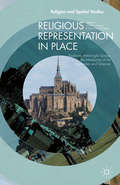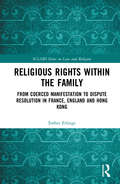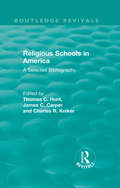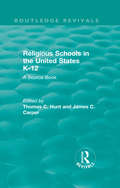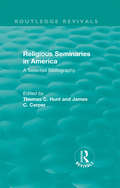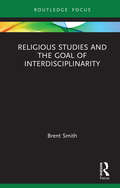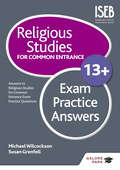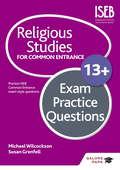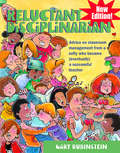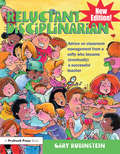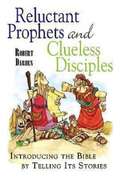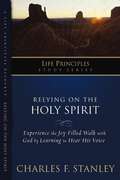- Table View
- List View
Religious Education in a Multicultural Europe
by Emer Smyth Maureen Lyons Merike DarmodyDrawing on a major EU-funded research project, this book examines how religious/secular beliefs are formed at school and in the family across different European countries, offering insights into key policy issues concerning the place of religion in the school system and illuminating current debates around religion and multiculturalism.
Religious Education in a Pluralist Society: The Key Philosophical Issues
by John Edwards Peter R. HobsonReligious education in liberal pluralist societies such as the UK, the USA, and Australian underwent radical change in the 1980s and 1990s, with a major shift towards multi-faith, educationally oriented programmes. This has meant significant modifications to both the content and the methodology of religious-education courses and to the way they are conceived of and taught in schools and universities.One important implication of this change for the teaching and study of religion today is the need for a philosophical dimension that deals with issues such as the truth status of religious statements and the moral acceptability of religious claims. This dimension is often insufficiently developed; this lack is made more critical by the multiple competing truth claims of various religions, giving rise to such contentious problems as the growth of fundamentalism, increasing religious intolerance and conflict, and differences of opinion on central moral problems such as birth control, abortion and euthanasia. This text attempts to provide the philosophical underpinning that the study and teaching of religion in modern societies requires.
Religious Education in a Post-Secular Age: Case Studies from Europe
by Olof Franck Peder ThalénThis book analyzes the changes and shifts in religious education in Europe over the past 50 years. In a post-secular age, it has become increasingly difficult to make sharp distinctions between what is religious and non-religious, confessional and non-confessional. Reforms in religious education in Sweden in the 1960s appeared as part of a process of wider secular liberalization, giving more credence to the idea of absolute neutrality in religious education. However drastic shifts in society, culture and the European religious landscape raise the need for a reevaluation of the foundations of religious education. Drawing on a range of case studies from across Europe, this book will appeal to students and scholars of religious education as well as post-secular education more generally.
Religious Education in the Early Years
by Dr Elizabeth AshtonThis volume looks at the role of Religious Education in the curriculum for the Early Years child. This book attempts to:*Discuss how to incorporate a wide range of religions in the classroom;*Consider how these can be explored in exciting and imaginative ways;*Help readers clarify their thinking on the subject;*Looks at the development of new approaches to the teaching of RE.Through studying practical examples and discussing what should be aimed at when considering good practice in the classroom, she provides a text that manages to be both inspirational and useful. This is a great addition to the RoutledgeFalmer series of books on Teaching and Learning in the First Three Years of School.
Religious Education in the Secondary School: An Introduction to Teaching, Learning and the World Religions
by James D. HoltReligious Education in the Secondary School is a comprehensive, straightforward introduction to the effective teaching of Religious Education (RE) in the secondary classroom. Acknowledging the highly valuable yet often misunderstood contribution of RE, this text shows how the subject can be taught in a way that explores the impact of religion on the lives of people and society, engaging pupils and preparing them to become individuals who celebrate and respect diversity. This second edition has been thoroughly updated and includes a new chapter on ‘Religion and Worldviews’ and new material on the development and assessment of an RE curriculum. It is illustrated throughout with ideas for teaching at different key stages and offers expert chapters introducing you to both the World Religions and the core aspects of effective teaching and learning. With an emphasis on developing an understanding of the importance – and different ways – of meeting the learning needs of all pupils, key chapters cover: • The nature of Religious Education. • What is religion and worldviews? • Understanding different pedagogies of RE. • Effective planning and assessment. • An approach to teaching across the Key Stages. • Core subject knowledge in Buddhism, Christianity, Hinduism, Islam, Judaism and Sikhism. Written by an experienced teacher, teacher educator and examiner, Religious Education in the Secondary School is a succinct compendium and has a real classroom applicability offering all trainee RE teachers, as well as those teaching Religious Education as specialists or non-specialists, a wealth of support and inspiration.
Religious Education in the Secondary School: An introduction to teaching, learning and the World Religions
by James D. HoltReligious Education in the Secondary School is a comprehensive, straightforward introduction to the effective teaching of Religious Education in the secondary classroom. Acknowledging the highly valuable yet often misunderstood contribution of RE, this text shows how the subject can be taught in a way that explores the impact of religion on the lives of people and society, engaging pupils and preparing them to become individuals who celebrate and respect diversity.? It is illustrated throughout with ideas for teaching at different key stages and offers expert chapters introducing you to both the World Religions and the core aspects of effective teaching and learning. With an emphasis on developing an understanding of the importance - and different ways - of meeting the learning needs of all pupils, key chapters cover: -Understanding different pedagogies of RE -Spirituality and RE -Tips on effective planning and assessment?? -An approach to teaching across the Key Stages -Core subject knowledge in Buddhism, Christianity, Hinduism, Islam, Judaism and Sikhism? Written by an experienced teacher, teacher educator and examiner, Religious Education in the Secondary School is a succinct compendium and has a real classroom applicability offering all trainee RE teachers, as well as those teaching Religious Education as specialists or non-specialists a wealth of support and inspiration.
Religious Education: A Conceptual and Interdisciplinary Approach for Secondary Level
by Clive ErrickerThe role of Religious Education in secondary schools is the subject of national and international debate. This book examines the current debates surrounding RE and puts forward a new approach to teaching the subject that is non-faith based and focused on conceptual enquiry and the development of a clear pedagogy. The book is based on the Living Difference learning model developed in Hampshire and adopted in other parts of the UK, which is sparking international discussion and provides an effective approach to implementing the new secondary curriculum. The chapters include examinations of: religious education and the curriculum an interdisciplinary approach to religious education the significance of pedagogy and learners’ development planning, progression, assessment and delivery specific case studies and examples of good practice in schools theoretical grounding and the future of RE the effects of globalisation, post-modernity and multiculturalism. Providing a basis for developing thinking about Religious Education, its place in the curriculum and how it can be delivered effectively in schools, this book is essential reading for tutors, students and teachers.
Religious Education: Philosophical Perspectives (Routledge Library Editions: Philosophy Of Education Ser. #17)
by John SealeyThe majority of books on religious education are written by those who are themselves adherents of particular religious beliefs and such books almost invariably reflect their authors’ religious inclinations. Therefore a critical look at certain key aspects in religious education from a secular point of view was long overview when this title was f
Religious Higher Education in the United States: A Source Book (Routledge Library Editions: Higher Education #12)
by Thomas Hunt James CarperOriginally published in 1996 Religious Higher Education in the United States looks at the issue of higher education and a lack of a clearly articulated purpose, an issue particularly challenging to religiously-affiliated institutions. This volume attempts to address the problems currently facing denomination-affiliated institutions of higher education, beginning with an introduction to government aid and the regulation of religious colleges and universities in the US. The greater part of the volume consists of 24 chapters, each of which begins with a historical essay followed by annotated bibliographical entries covering primary and secondary sources dating back to 1986 on various denomination-connected institutions.
Religious Literacies in Educational Contexts: Interdisciplinary Perspectives (Routledge Research in Religion and Education)
by Sabrina D. MisirHiralall Kate E. SoulesReligious Literacies in Educational Contexts: Interdisciplinary Perspectives provides an overview of current scholarship on religious literacy and its practical applications in public life.As an emerging, interdisciplinary field, religious literacy is vital in understanding how diverse religious beliefs shape social and political landscapes. This volume aims to deepen the conversation among scholars and practitioners by offering actionable recommendations for promoting religious literacy in educational contexts. Key questions addressed include: What does religious literacy mean in different contexts? Why is religious literacy important today? How can educators and scholars foster religious literacy in public settings? This book provides an exploration of these questions as the authors offer an overview of the current scholarship on religious literacy along with its applications in the classroom for both scholars and practitioners.This book is designed for scholars, educators, and practitioners interested in the intersecting fields of religion, education, and public life highlighting the significance of religious literacy in various disciplines and contemporary issues by providing readers with insights and strategies to enhance their understanding and teaching of religious diversity.
Religious Literacy, Law and History: Perspectives on European Pluralist Societies (ICLARS Series on Law and Religion)
by Alberto Melloni Francesca CadedduThe book profiles some of the macro and micro factors that have impact on European religious literacy. It seeks to understand religious illiteracy and its effects on the social and political milieu through the framing of the historical, institutional, religious, social, juridical and educational conditions within which it arises. Divided into four parts, in the first one, One literacy, more literacies?, the book defines the basic concepts underpinning the question of religious illiteracy in Europe. Part II, Understanding illiteracies, debating disciplines?, highlights the theological, philosophical, historical and political roots of the phenomenon, looking at the main nodes that are both the reasons religious illiteracy is widespread and the starting points for literacy strategies. Part III, Building literacy, shaping alphabets, examines the mix of knowledge and competences acquired about religion and from religion at school as well as through the media, with a critical perspective on what could be done both in the schools and for the improvement of journalists’ religious literacy. Part IV, Views and experiences, presents the reader with the opportunity to learn from three different case studies: religious literacy in the media, religious illiteracy and European Islam, and a Jewish approach to religious literacy. Building on existing literature, the volume takes a scientific approach which is enriched by interdisciplinary and transnational perspectives, and deep entrenchment in historical methodology.
Religious Literacy: What Every American Needs to Know and Doesn't
by Stephen ProtheroWe as a people know little about the religions we champion.
Religious Minority Students in Higher Education (Key Issues on Diverse College Students)
by Yoruba T. Mutakabbir Tariqah A. NuriddinThe most recent addition to the Key Issues on Diverse College Students series bridges theory to practice in order to help student affairs and higher education professionals understand the needs and experiences of religious minorities on college campuses. Religious Minority Students in Higher Education explores existing literature and research on religious minorities on American college campuses, discusses the challenges and needs of religious minorities on campus, and provides best practices and recommendations. Providing a foundational, nuanced approach to religious minorities in the American college context, this important resource will help educators at colleges and universities promote religious pluralism and tolerance to support student learning outcomes and campus inclusion among students of diverse religious backgrounds.
Religious Representation in Place: Exploring Meaningful Spaces at the Intersection of the Humanities and Sciences (Religion and Spatial Studies)
by Mark K. George Daria Pezzoli-OlgiatiReligious Representation in Place brings together an interdisciplinary group of scholars from the Humanities and Sciences to broaden the understanding of how religious symbols and spatial studies interact. The essays consider the relevance of religion in the experience of space, a fundamental dimension of culture and human life.
Religious Rights within the Family: From Coerced Manifestation to Dispute Resolution in France, England and Hong Kong (ICLARS Series on Law and Religion)
by Esther ErlingsIt is often asserted that ‘A family that prays together, stays together’. But what if a child no longer wishes to pray? This book analyses the law in relation to situations where parents force their children to manifest the parental religion. From thorough examination of international law it argues that, unlike what is generally believed, the human rights regime does not grant parents a right to impose manifestations of their religion on their children. Instead, the author proposes to regard coerced manifestations as a limitation on children’s right to freedom of manifestation, based on national laws that give parents rights at the domestic level under principles such as parental responsibility. The book focuses on two aspects of States’ positive obligations in this regard. First, the obligation to provide a regulatory framework that can protect children’s right to freedom of manifestation, and restricts limitations to those that are proportionate or 'necessary in a democratic society'. Second, to provide access to remedies, which it is argued should consist of access to a family-friendly infrastructure for dispute resolution available to parents and children in conflict over religious manifestation. Both depend heavily on the way States balance power between parents and children at the national level. The book includes three case studies and social research of jurisdictions that offer different perspectives under the principles of parental authority (France), parental responsibility (England) and parental rights (Hong Kong).
Religious Schools in America: A Selected Bibliography (Routledge Revivals)
by Thomas C. Hunt James C. Carper Charles R. KnikerPublished in 1986, this selected bibliography considers private schools that are religiously affiliated. Divided into several sections the book open with chapters covering the most influential general books on religion and schooling and offers summaries and analysis of court decisions and commentaries on the issues of government aid and regulation. The book goes on to provide entries of the schools operating in the United States by seventeen religious groups, entries are annotated by experts from the field. The final section of the book considers statements on religious schools made by both public school educators and religious school advocates; formal and informal interactions between the public and religious schools; and the concept of the education of the public by religious and public schools. This work pulls together a wealth of reference material, mainly on religious schools, and provides a much-needed resource for those interested in religious schooling, whether researcher, scholar, student or policy-maker.
Religious Schools in the United States K-12: A Source Book (Routledge Revivals)
by Thomas C. Hunt James C. CarperFirst published in 1993 this volume is an extension and revision of the 1986 book entitled Religious Schools in America: A Selected Bibliography. This new version contains additional annotated bibliographies of the various denominational schools as well as discussing governmental relation to each setting in the years from 1985 to 1992. This version also covers Greek Orthodox and Muslim schools that were not part of the previous volume and includes a chapter on the growth of home schooling which is often influenced by religion. Finally, unlike the previous edition, this book only considers religious schools, rather than the religious aspect or function of public schooling. Each section includes a short chapter followed by an extensive annotated bibliography making it a useful source for anyone looking for information in the area.
Religious Seminaries in America: A Selected Bibliography (Routledge Revivals)
by Thomas C. Hunt James C. CarperPublished in 1989, this bibliography considers religious seminaries that are affiliated with the various denominations of the theological institutions established in the United States by the Protestants in the early 1800s, it also considers non-denominational and independent settings. Divided into two sections, the first short section considers the relationship between the civil governments and the seminaries, the second, organized by denomination into 15 chapters provides an extensive bibliography with annotations. The work pulls together a wealth of reference material and identifies salient works, whether book, article, dissertation or essay, to provide a much-needed resource for those interested in seminary education in the United States, whether scholar, student, policy maker, or interested citizen.
Religious Studies and the Goal of Interdisciplinarity (Routledge Focus on Religion)
by Brent SmithThis book offers a survey of the development of interdisciplinarity in religious studies within academia and offers ways for it to continue to progress in contemporary universities. It examines the use of the term ‘interdisciplinary’ in the context of the academic study of religion and how it shapes the way scholarly work in this field has developed. The text uses two main elements to discuss religious studies as a field. Firstly, it looks at the history of the development of religious studies in academia, as seen through an interdisciplinary critique of the university as an epistemological project. It then uses the same interdisciplinary critique to develop a foundation for a 21st-century hermeneutic, one which uses the classical concepts reprised by that interdisciplinary critique and retools the field for the 21st century. Setting out both the objects of religious studies as a subject and the techniques used to employ the study of those objects, this book offers an invaluable perspective on the progress of the field. It will, therefore, be of great use to scholars of research methods within religious studies.
Religious Studies for Common Entrance 13+ Exam Practice Answers
by Michael Wilcockson Susan GrenfellThis book provides all answers, as well as marking guidance, to the questions in the accompanying title Religious Studies for Common Entrance 13+ Exam Practice Questions. - Endorsed by ISEB- Provides extensive advice and guidance to help pupils achieve top marks - Saves time marking work and helps identify areas requiring further study
Religious Studies for Common Entrance 13+ Exam Practice Questions
by Michael Wilcockson Susan GrenfellThis book contains over 900 exam-style questions based on Syllabus A of the 13+ ISEB Common Entrance exam; it is ideal for pupils who are looking to achieve top grades in entrance exams at 13+. The guide is laid out to correspond with the examination paper and includes sections on Biblical Stories, World Religions and Contemporary Issues, allowing pupils to familiarise themselves with the format of the exam. It also includes advice on how to answer exam questions.- Endorsed by ISEB- Ideal for pupils working towards Syllabus A of the Religious Studies Common Entrance exam at 13+- Features rigorous exam-style questions for realistic practice
Reluctant Disciplinarian
by Gary RubinsteinIn this funny and insightful book, Gary Rubinstein relives his own truly disastrous first year of teaching. He begins his teaching career armed only with idealism and romantic visions of teachin--and absolutely no classroom management skills. By his fourth year, however, he is named his school's "Teacher of the Year." As Rubinstein details his transformation from incompetent to successful teacher, he shows what works and what doesn't work when managing a classroom. Just a few of his ideas: Develop a teacher look. The teacher look says, "There's nothing you can do that I haven't already seen, so don't even bother trying." Show students that you are a "real" teacher by doing things they expect of real teachers, at least for a while. Be prepared to utter a decisive answer to anything within two seconds. Decisive answers inspire confidence. Any teacher--experienced or not--will enjoy this honest and humorous look at the real world of teaching and will come away with some very helpful ideas for classroom management. The book is used all over the country in teacher preparation programs. Ben Guest, Program Manager for the Mississippi Teacher Corps describes the book as "That rare classroom management book that is both thoughtful and realistic. It is also a great read, with parts that are laugh-out-loud funny."
Reluctant Disciplinarian: Advice on Classroom Management From a Softy Who Became (Eventually) a Successful Teacher
by Gary RubinsteinIn this funny and insightful book, Gary Rubinstein relives his own truly disastrous first year of teaching. He begins his teaching career armed only with idealism and romantic visions of teaching—and absolutely no classroom management skills. By his fourth year, he is named “Teacher of the Year.” As Rubinstein details his transformation from incompetent to successful teacher, he shows what works and what doesn't work when managing a classroom such as:Develop a teacher look. The teacher look says, “There's nothing you can do that I haven't already seen, so don't even bother trying.”Show students that you are a “real” teacher by doing things they expect of real teachers, at least for a while.Be prepared to utter a decisive answer to anything within 2 seconds. Decisive answers inspire confidence.Any teacher—experienced or not—will enjoy this honest and humorous look at the real world of teaching!
Reluctant Prophets and Clueless Disciples: Introducing the Bible by Telling Its Stories
by Robert DardenIt was once said that all a person has to do to realize God has a very good sense of humor is to look at a platypus. The same sentiment applies to the Bible. The Bible often seems like foreign territory, not only for students encountering it in introductory classes, but also for those who have spent many years in church. To many people, it is an intimidating collection of rules, lists, and theological arguments. But in reality, most of the Bible is made up of fascinating stories. Sometimes they're funny, sometimes they're weird, sometimes they're inspiring, but they're never dull. This college-level introduction invites students into biblical studies through creative, humorous retellings (and a few cartoons here and there) of the basic biblical narratives. The best way to get into the Bible, says Robert F. Darden, is to get to know its stories. In this new approach to introducing the Bible to students, Darden covers the major biblical stories and characters, retelling them in such a way as to bring out their original humor and pathos, and inviting the student to encounter them more fully by moving into the text itself.Click here to listen to Terri Gross's interview with Robert Darden on NPR's Fresh Air about the Black Gospel Music Restoration Project. Darden runs the project at Baylor University where he is a journalism professor. The purpose of the project is to identify, acquire, preserve, record, and catalogue the most at-risk music from the black gospel music tradition, primarily between 1945 and 1970.
Relying on the Holy Spirit (Life Principles Study Series)
by Charles F. StanleyThe Life Principles Study Guides are perfect companions to Dr. Stanley's Life Principles Bible or for use on their own. They are a unique approach to Bible study, incorporating biblical truth, personal insights, emotional responses, and a call to action. Whether you use a study in a group or as an individual, it will help you get in touch with the Bible, God, and yourself.
